“Home is where the heart is”; “there’s no place like home”; “it’s so good to be home”. Yes, a home is important. In the words of George Carlin, it’s also a place to hold our “stuff”. And it’s also a place to sleep, to eat, to keep you out of the rain and cold, a place in which to feel secure, a space to share with loved ones, a place to enjoy and love. A home is cozy and comfortable.
Over my 75 years I’ve lived in many homes and looking back on them each place had an influence on me and was significant for me. And each home in which I have lived has provided indelible memories, mostly good. And when I visualize each place where I have lived I realize that it has provided something special to me – the unique experiences, the people with whom I lived, the feelings generated by daily life in that home. As such, the homes in which all of us have lived form an important biographical thread in the fabric of our lives. What follows is that thread for me, a narrative of places where I have lived, divided into three parts: Part I 1942 to 1972, Part II 1972 to 1983 and Part III 1983 until now. Here’s the first part.
Part I

Barbara and I at Sunset Farm 1942
I was born in Somerset Hospital in Somerville, New Jersey and as an infant lived on Sunset Farm, a residence and farm buildings owned by the church of which my parents were members. This place preceded my memory but visiting it as a young adult and seeing pictures taken there when I was very young enables me to speculate on what life was like there for my mother, already caring for four year old Barbara, with infant me and shortly after, another pregnancy and my sister Elaine, to be born while we lived there also.

Barbara, Elaine and I 1945 (note the wartime wood construction of the stroller and wheelbarrow)
In 1945 or so my family was assigned by church authorities to live at a church home in Oakland, California, where my brother Robert was born. At this house my memories began, with hazy impressions of a trip on the Oakland Bay Bridge with its multiple suspension spans, a tunnel and then multiple truss spans. I recall seeing somewhere from this bridge a Sherwin Williams sign with neon animation spilling paint down over a neon globe.

Elaine and I, 1946 or so
And at our house I recall spotlights filling the sky, maybe having something to do with the war with Japan. And I remember looking for pretty stones in an area between the rungs of a ladder lying where rain fell from the roof. I also recall as a little boy marching around an oval rug chanting “round round Hitler’s grave”. Apparently this ditty came from an Almanac Singers song in 1942 but I don’t remember how I came to know it. I also have a memory of clouds of fighter planes flying overhead, probably from a nearby Air Force base.

Barb, Elaine and I
The next home to which my family moved in 1946 or ’47 was a church home called “Lock Haven”, on Canal Road about a mile east of the little church community town called Zarephath, between the towns of Bound Brook and Manville, New Jersey. We shared this large rather ramshackle house of graying and peeling white wood siding with several others – an elderly couple, the Schisslers, and an elderly single man, Mr. Wittekind. We occupied the two floors in the main part of the house, with the Schisslers in the lower floor of an addition and Mr. Wittekind in a single room above.

Me, Rob, Barb and Elaine, forsythia and swings in background 1947 or so
Outside was a long cinder driveway meeting a gravel main driveway that went left to the barnyard of a large gray barn and to the “bee house” where Mr. Wittekind kept his bee equipment: some “smokers”, extra hives, beeswax frames and a large centrifuge. (I knew about this paraphernalia because after Mr. Wittekind’s passing, my Dad tried to take over and learn the bee business.) The gravel driveway to the right went downhill to Canal Road which to the left took you to Zarephath and beyond to Weston, Manville and Somerville or to the right to Bound Brook, South Bound Brook and towns beyond, like Dunellen, Plainfield or New Brunswick.

Robert outside the Lock Haven house with the forsythia
Around the house were maple trees, forsythia bushes, grass lawns and a large lilac bush, which you could actually enter and navigate little paths among the stems and branches. Adjacent to some large forsythias was a rusty and old but still serviceable set of swings which we kids enjoyed. There was also an incongruous small hexagonal building with maroon shingles on its exterior which my sister Barb used to raise her flock of ducks. The big barn was used for storing some church farm implements and stacks of bales of hay in the haymow. The haymow had that wonderful unique smell of old wood and hay, not readily describable but instantly recognizable and known only to people who have experienced barns in their lives.

Charlie and Elaine, Lock Haven barn in background
The driveway left extended beyond the beehives and bee house and eventually met a dirt road which left would take you to the Tabor (another church home which anchored the farm operations) peach and apple orchards and right would take you to past some hayfields on to Zarephath, our “church town” which I will describe elsewhere. That right turn would first take you over a culvert containing our little creek, in which I occasionally “fished” for non existent fish with a stick, a string and a piece of wire “hook”, while letting my mind run on about fishing and a thousand other things.

Me, Columbia bicycle and our ’49 Chevy
Across Canal Road from the house was “the canal”, our simple colloquialism for the Delaware and Raritan Canal, an old formerly important transportation artery constructed in the 1830’s connecting the Delaware River and the Raritan River and used for about a hundred years to transport cargo between Philadelphia and New York City. It was only later that I realized that the path on the canal bank that I knew as the “toe path” was really “tow path”, the path worn by the horses and mules that had towed barges on the canal. “The canal” played an important role in our lives during those years in Zarephath. I learned to swim in the canal, as well as doing my first real fishing. And in the winter, when the canal froze, you could ice skate all the way to Princeton, getting off the ice to walk around the bridges and locks between.

Elaine, Rob, me and Charlie, lilac bush in background
It was at Lock Haven that big sister Barbara raised her flock of ducks and Dad and Mom raised several flocks of chickens to sell. For some reason both Mom and Dad frowned on pets so there were never any dogs or cats to pet, love and take care of. But one time when Dad had a flock of speckled Plymouth Rock chickens there was one all-black chicken among them that got picked on all the time by the others for being different. I used to protect this chicken, put him under a crate to keep him safe and gave him his own food and water and he became, believe it or not, my pet, even coming to me when I called his name, “Blackie”. So, Tommy Smothers, you weren’t the only kid who had a pet chicken!

Me, Blackie, Elaine
The tall chimney over the kitchen and dining room of the Lock Haven house went down during Hurricane Hazel in 1955, thankfully not penetrating the roof, which likely accelerated our move to another church residence – “Morningside”, about a mile west of Zarephath. This house, which also served as the home of another family, the Chambers, was located among some flat, fertile fields, the floodplain between the Canal and the Millstone River, a tributary of the Raritan River.
This house was small for a family of our size. At Lock Haven Charlie had arrived, born at home and Richard also, right before we moved, making eight of us to fit into three upstairs bedrooms. Later an addition was built onto the house and Mom and Dad’s bedroom moved downstairs, making it a bit more tolerable for us six kids upstairs. Of course, while in this house, Glenn and Stan were added to the family making the final eight, so it was always crowded. I initially shared a bedroom with Robert and Charlie so the three of us became quite territorial, in order to share the space and the drawers of one dresser. Barbara and Elaine were in another bedroom.
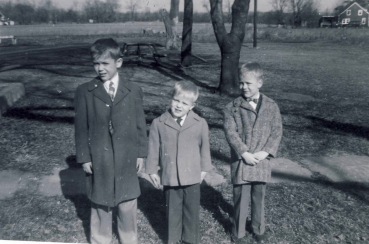
Richard, Stan and Glenn at Morningside
The childhood memories that accumulated in this house were many, and included assembling serviceable bicycles from the pile of accumulated parts in the garage each spring and riding them on the many dirt roads in the immediate area, to participating in Dad’s truck farming operation, which blossomed into running a roadside stand on the “Weston Causeway”, the road between Canal Road and Weston Road into Manville. The stand was run by the younger kids, namely Charlie and Richard, while Rob and I and sometimes the girls helped with the planting, cultivation and harvesting of strawberries, sweet corn, tomatoes, and other vegetables.
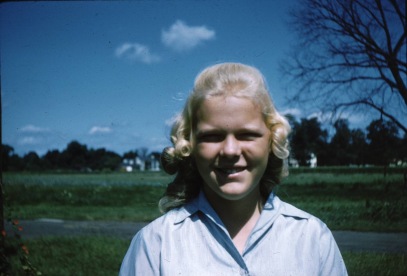
Elaine outside, Millwood across the fields
Another fond memory was rocking my little brother Richard asleep in his wheeled baby basket while I listened to The Lone Ranger, Jack Benny and other popular radio shows from the 1950’s. Also I remember my Dad’s “It’s a girl!” joke when my brother Stan was born. After four boys in a row, all of us older kids had hoped for a little sister. But it was not to be, it was our last sibling, dear brother Stan instead.

Rob in back, Glenn, neighbor Celeste Chambers, Richard and Stan in front
While living at Morningside I made my first foray into radio and sound reproduction. It was there that I assembled a mail order crystal set, a rudimentary radio that picked up a signal from a connected bedspring antenna and was listened to on a set of headphones. I could not believe at the time that this little gadget actually picked up WOR from New York City as well as our local religious station, WAWZ. It was also at this house where as a teenager I assembled my first really good sound system – an Eico amplifier I built from a kit, a 15 inch Jensen coaxial speaker that I mounted in an old wooden radio cabinet, and an old Garrard turntable. It was on this system that I used to blast Rossinni’s William Tell Overture and Tchaikovsky’s 1812 Overture as well as Fats Domino and Little Richard.

Elaine and Charlie in front of Morningside house
The yard of this house also contained several symmetrical and eminently climbable maple trees, in one of which I fashioned a nice seat-back from baling twine in a fork of three branches high up in the tree. This became my redoubt in which to escape from the noise and chaos of my little brothers. Today looking back I can think of nothing more relaxing than climbing that tree with a sack of tomato sandwiches in my belt and a good book in my hand and settling back in that comfortable seat, reading my book, eating my sandwiches, feeling the tree gently sway and hearing the leaves rustle from a warm summer breeze, above it all, away from it all, in total privacy and relaxation. Yes, I could still hear the noise but I was above it all and thus quite removed.

Glenn, Richard, Stan, Murphys’ house in background
Other memories I associate with this house are a unreliable heating system which allowed the glass of water by my bed to freeze one winter night, and the several early spring floods we had. Being in the floodplain of the Millstone River, the area was vulnerable to flooding and we did experience a couple of these, when water ran down the cellar steps in a waterfall, causing havoc with Mom’s jars of canned fruit and vegetables and presenting a huge cleanup job when the flood subsided and water was pumped out. The house looked like an island in the middle of a huge lake and it was exciting to work with my brothers making rafts and then floating out into the deeper water.

Charlie among the maple trees 1960
“Morningside” was located about a mile away from the church headquarters town, Zarephath, and was conveniently reached on the Weston Canal Road or on the “back road” a road past “Millwood”, another church home, through the woods and over the dike (an earthen structure to protect Zarephath from the occasional Millstone River flooding and down into our little church “town”. And halfway along our long cinder driveway from the Weston Causeway was the home of the Murphy’s, another church family.

All six Friedly boys at the Morningside house, ’56 or ’57
In the fall of 1958 I was sent to the church school in Westminster, Colorado for my senior year of high school, got into some trouble there and in November was sent to live with my Aunt Margaret and Uncle Emil in Wooster, Ohio. The Wooster High School chapter of my life will be discussed elsewhere on this blog but in terms of a home, I lived in a really nice house, the first family home that my uncle, a general contractor, had built for his family. Built on a hillside in the farmland outside of Wooster, the basement of this beautiful house with real redwood siding was exposed in the back where you could enter and exit through a basement door. It also had a two car garage attached to the house by a breezeway. While there I lived in a comfortable basement bedroom with access to my own bathroom. I was with my Aunt and Uncle through my graduation and into most of July when my parents picked me up to return home to New Jersey and start college at Rutgers University in nearby New Brunswick. Before I left that summer I was able to work for Uncle Emil and receive firsthand a valuable introduction to basic carpentry skills, which I have used my whole life. I also painted, actually stained, the entire house before I left in August. I could not find a picture of this 1958 – 1959 home in my files.
During my first two years of college I again lived at home but obviously spent little time there since conditions were never appropriate to promote study and deep thought. I loved my little brothers but study there was impossible, so I spent most of the day and evening at Rutgers (see “Chaos: My Undergraduate Education”, to be published soon).
After my second year at Rutgers and after some disagreement with my father, I moved to Denver, Colorado and lived in several different apartments at 3001 Umatilla St. From here I could easily get on Speer Boulevard and then on Interstate 25 to get to my job at Navajo Freight Lines on South Santa Fe Drive. I began living there in a one room efficiency apartment where I slept on what was my couch during the day. After a couple of months I moved to a one bedroom unit with a roommate, John Griego. Later, having befriended a couple of Regis College students, Rich Byrne and Ken Adams, I moved into a three bedroom unit with them, all the while working at Navajo. Later that year, a couple of girls in another apartment whom we had befriended, Jerrilyn Rickey and Janice Goddard, joined me in deciding to leave the apartments and rent a furnished house. We did so in south Denver. I cannot remember the address but the experience of being in an actual house with these roommates was rather pleasant. Janice had a little baby girl so Janice, Jerrilyn and I seemed like an interesting little family. Eventually Janice and her little girl moved back to Alaska, Jerrilyn back to Montrose, Colorado and I rented my fourth residence during that year and a half in Denver, a small furnished apartment in central Denver. I don’t remember too much about this little place except that it was comfortable, furnished and conveniently located. Nor could I locate a picture of it in my files or elsewhere.

3001 Umatilla, Denver, Colorado
I returned from Denver in 1962 to live at home for awhile, found a job and resumed my education at Rutgers at night. After getting married in 1963, my wife Elaine and I lived in a one bedroom apartment adjacent to the Rutgers New Brunswick campus – 85 Easton Avenue. A half block away was a Rutgers gathering place called Olde Queens Tavern, very convenient for a quick hamburger or a take-out pizza. Adjusting to marriage, Elaine and I had some loud differences of opinion while in this apartment and I remember being shocked once, when lying on the bed during the day, that I could hear a phone being dialed by my next door neighbor – yes, the walls were that thin and I am sure my poor neighbor had heard all the anger and profanity that had passed between us. For awhile, my brother Robert, who had just started at Rutgers, lived around the corner from us in a small empty store-front that had been turned into a small apartment.
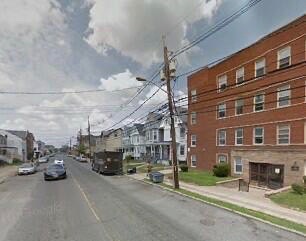
85 Easton Avenue, New Brunswick, NJ
About the time I graduated and began teaching, we moved into a new apartment complex at the junction of Route 18 and US 1 in New Brunswick – 200 Hoffman Boulevard. This apartment was convenient to my job at Irwin School in nearby East Brunswick but also convenient to a number of part time jobs I held at that time. Elaine had started work for a pediatrician, Dr. Hyman Gelbard, at about this time, whose office was also readily accessible. The apartment complex had a swimming pool perched right above the noise and exhaust from US Highway 1 which we used to enjoy, despite the fumes. I have not seen these apartments in many years but we entertained many guests while there, both friends and family.
While staying in the same complex, we later moved from our apartment in order to escape the noise from college student neighbors underneath us to another in the next building, only to find the same problem, this from the neighbor above us, forever fixing a powerful aversion to living next to, above or below anyone at all in an apartment house. It was at this time too when through Elaine and her contact with drug detail men, I began to take pills to sleep or pills to keep me alert (see “My World of Work”) as I worked a number of part time jobs, in addition to my full time job of teaching, to help make ends meet.
In 1968, after obtaining the job with the Bureau of Indian Affairs, we moved to Pinon Boarding School in Pinon, Arizona, a million miles from nowhere, right smack in the middle of the vast Navajo Reservation at the end of a 45 mile paved road west from Chinle. I recall vividly the Mayflower truck drivers’ comments when delivering our furniture to our primitive cinder block duplex on a mud-filled alley (can’t call it a “street”) in Pinon – “Are you guys out of your minds?” These were the same drivers who had picked up our furniture from our significantly more luxurious apartment home in New Jersey.

Pinon Trading Post 1969
One of the Navajo Reservation school complexes that one passed on the way from Chinle to Pinon was a new day school called Cottonwood, which had, in addition to new school buildings, a dozen or so brand new individual houses for teachers. Actually I had initially thought that this was our Pinon destination on the road from Chinle; it was disappointing that it was not and we had to go on – to old Pinon Boarding School, with the main school building a WPA – built structure and other buildings – the dormitories and residences – painted cinderblock. But our time in Pinon was indeed exciting and memorable. It was at Pinon Mercantile, the local trading post where I met a lifelong friend, Bill Malone, his lovely Navajo wife, Minnie, his stepson and his three little girls.

Bill Malone and daughters 1968
I had read about and finally got to meet the notable BIA school administrator, Wayne Holm, who at his school, Rock Point Boarding School, had formed the first functioning Navajo School Board and had instituted a number of innovative instructional strategies so I applied to be transferred to his school, close to a hundred miles from Pinon. Wayne said he wanted me so we packed up and moved again, this time at our expense and this time in a U-haul truck or a borrowed pickup truck. We moved to a nice single family 3-bedroom house, similar to those I had noticed at Cottonwood, in the residential area of Rock Point School, which cost us, as I recall, about $24 per bi-weekly paycheck. We paid for the utilities.
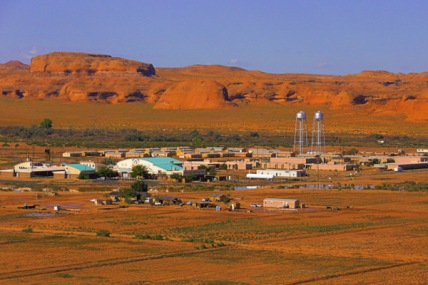
Rock Point School, housing in background
We were at Rock Rock Point for just one year, since I had applied for and was admitted to a post-masters program at Harvard Graduate School of Education. So we sold all of our furniture that had been carefully transported from New Jersey to Pinon and less carefully transported a year later from Pinon to Rock Point, packed what was left in our new VW Kombi and headed to Cambridge, Massachusetts, where we had been fortunate enough to get into Harvard married student housing, a high-rise near the Charles River called Peabody Terrace.
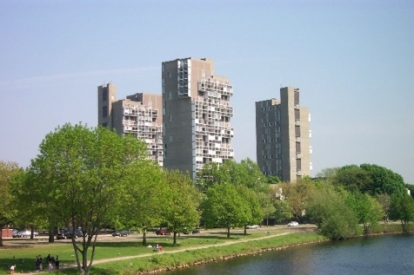
Peabody Terrace, Harvard married student housing
Our home here for one year, 11 Peabody Terrace, apartment 412, was a partially furnished studio apartment on one of the upper floors, where we had a table and chairs, a mattress on the floor, stereo equipment, LP records and books in a brick and board bookcase, a couch and a desk. I can’t really remember what we brought with us in our VW but it could not have been much – we certainly had stripped ourselves down to the bare essentials – maybe the desk and the table and chairs since we had sold our living room sectional couch, coffee and end tables to my friend Bill at Pinon and sold our beautiful Spanish “distressed finish” dark wood bedroom set to someone at Rock Point. Everything that mattered to us at that time was packed into our vehicle – essentially clothes, music and books. Also, our dog, Seymour, from the Rez, must have come with us because he was with us in Marshfield and Plympton, our next two residences, but I don’t remember traveling with him at all – must have been because he was such a good dog. Nor do I remember him in Cambridge. Maybe he was somewhere else at that time? But where? Did someone take care of him for us? I simply do not remember.
Finishing my year of school, I obtained my first school administrative job as Assistant Principal at Duxbury Elementary School in the south shore community of Duxbury, about 30 miles south of Boston. Our first move to this area was to a small furnished rental a couple of blocks from the beach in Marshfield, the next community north from Duxbury. A small two bedroom house without a garage, this place was ideal as we tried to settle down after the year of school in Cambridge.
After my first year in Duxbury, we bought our first house at 69 Ring Road in Plympton, Massachusetts, about a twenty minute drive to my job in Duxbury. The house was built by a local contractor and landowner who also sold building lots. It was quite modest sized, three bedrooms and one bath with attached two car garage, although to us it seemed very spacious. It was basically a ranch style and was covered with attractive New England style cedar shingle siding. We enjoyed this, our first real house, the first home that we actually owned. It was built on a two acre wooded lot and was located well off the road, hidden back among the trees. I recall a pleasant walk behind the house among some lovely hemlock trees, especially beautiful after a winter snowfall had decorated the branches. It was here that we replenished our furniture, buying much of it from Jordan Marsh warehouse in Quincy. Having built my first stereo amplifier made by Heathkit and the pair of KLH speakers bought while at 85 Easton Avenue in New Brunswick, it was at this house that I finally assembled and finished a beautifully designed music component console made by Furn-a-kit which held the amplifier, tuner and turntable with shelves and sliding enclosures for our LP records on each side.
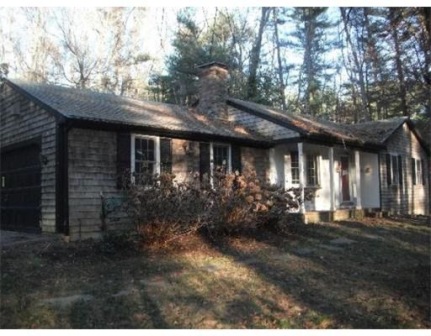
Our house at 69 Ring Road, Plympton, Massachusetts
It was at this house where my brother Robert visited us from Germany, where he had made his home after serving as an officer in the Army. Accompanied by his girlfriend Helma, we enjoyed his visit very much. Rob also pitched in to assist in some landscaping outside and uphill from the house. As I remember it was a sort of rock retaining wall by the garage. Another memorable occasion was a surprise visit was from my cousin Sandy. We took him into Boston for a superb club concert by the incredibly rich-voiced blues singer Tracy Nelson.
This concludes the first section of “Home Sweet Home”. My memory, though pretty good for a guy my age, may have provided some inaccurate information, so please don’t hesitate to let me know if something needs to be corrected. All articles on this blog are really works in progress, anyhow. My second and third sections are written and will be published as soon as they can be illustrated.